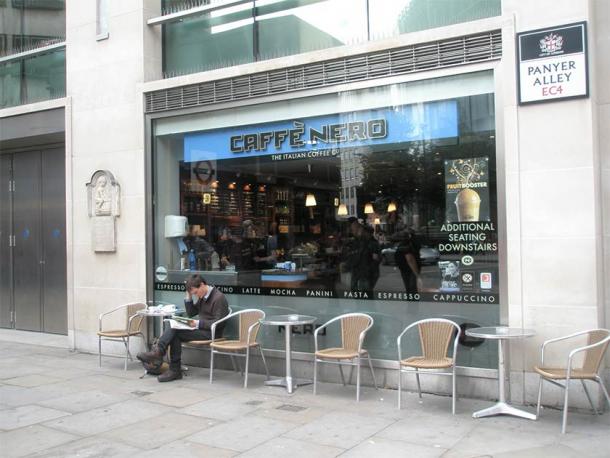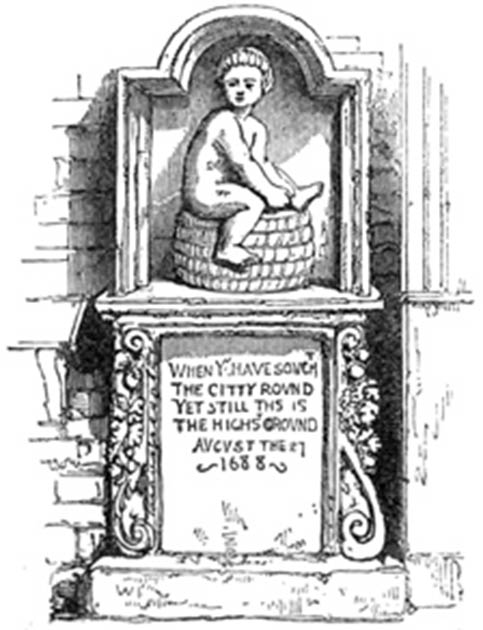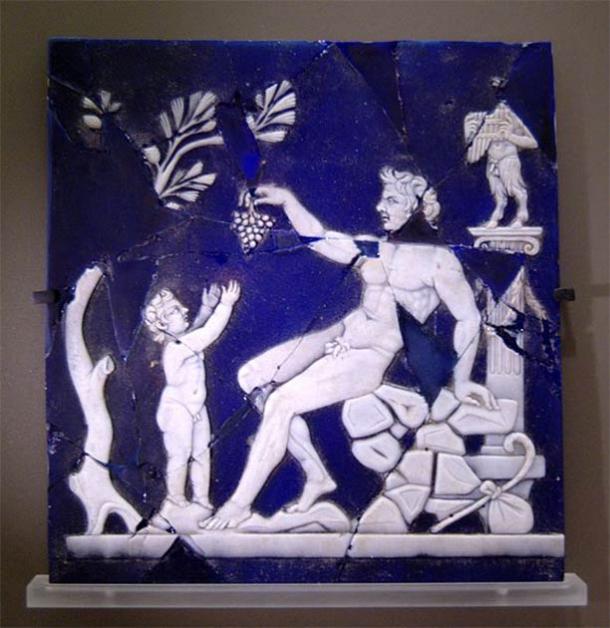The Panyer Boy is a mysterious relief found in London. As indicated by its name, the sculpture depicts a boy seating on what seems to be a basket. Additionally, there is a stone plaque with an inscription on it. Based on the inscription, it is assumed that the Panyer Boy dates to the 17th century. Additionally, the inscription also claims that that spot is the highest point in London. Despite the fact that written accounts of the Panyer Boy appear as early as the 18th century, the relief is an enigma, and there are still many unanswered questions surrounding it.
The Panyer Boy can be found on Panyer Alley off of Cheapside, at the top of the steps of St. Paul’s tube station. The relief is not difficult to spot, as it is located on street level on the wall beside a Caffè Nero.

The Panyer Boy relief is beside a Caffè Nero on Panyer Alley. (Bashereyre/ CC BY SA 3.0 )
But this was not always the case. For many years, the Panyer Boy was on ground level, on a wall between two houses. In November 1892, one of those houses was pulled down, and rebuilt some months later. Newspapers at that time reported that a “rich American” tried to bribe one of the workmen at the site to let him have the relief. The workman, however, reported the incident to the authorities and the police were dispatched to keep guard over the Panyer Boy until it was re-embedded in the wall.
What is the Panyer Boy?
The Panyer Boy depicts a naked little boy seated on a basket. Incidentally, the word ‘pannier’ may refer to a large basket. A lot of the details of the boy are no longer visible due to weathering and damage over the centuries. There are, however, old drawings from the 18th or 19th century, which allow us to have a better idea of how the relief looked before suffering from erosion.

Panyer Boy drawing from 1889. ( Leigh Hunt )
One of the most common interpretations of the relief is that the boy is sitting on a bread basket. This is based on its association with Panyer Alley, where in the past, boys / bakers would sell their bread from a bread basket.
Although the Panyer Boy may have been created to commemorate the bread sellers of the area, an alternative suggestion states that the relief was created as a sign for an inn. According to this version of the story, there once was an inn called ‘The Panyer’, which once stood around the corner on Paternoster Row. The last incarnation of the inn burned down in 1666, during the Great Fire of London . It is due to this inn that the alley is known as Panyer Alley.
Alternative Interpretations of the Panyer Boy’s Identity
Both of the interpretations fall apart, however, if one were to question whether the basket is indeed meant to depict a bread basket. For instance, Thomas Pennant, a Welsh naturalist, traveler, and antiquarian, mentions the Panyer Boy in his 1790 work, Of London . Although Pennant entertains the common idea that the boy is sitting on a basket, he also questions if the boy might be sitting on a coil of rope, a sack of wool, or a barrel.
Apart from that, Pennant wonders what the Panyer Boy was meant to represent. In addition to the bread sellers hypothesis, Pennant offers his readers the idea that it could have been a sign for a brewery, as there used to be a Panyer Brewhouse near the site, whose existence was recorded as early as 1426.

The Panyer Boy relief. ( chrisdorney /Adobe Stock)
Pennant also mentions that the boy is holding something in his hands. While the effects of weathering and damage have made it impossible for us to determine what the Panyer Boy was holding in his hands, Pennant seems to have had questions about this as well. If the Panyer Boy were a bread seller, it would be natural to assume that he is holding a loaf of bread. Pennant, however, also considers the possibility that the boy is holding a bunch of grapes or his own foot.
With regards to the latter, Pennant suggests that the Panyer Boy might be trying to remove a thorn from his foot, and reports that apparently the relief was referred to by locals as ‘pick my toe’. On the other hand, some are more in favor of the bunch of grapes idea, and even suggest that the boy is crushing the grapes with his foot. This has led to the interpretation that the Panyer Boy represents an infant Bacchus, the Roman god of wine.

Satyr giving a grapevine to Bacchus child. Cameo glass, 1st half of the 1st century. From Italy. ( Public Domain )
The Relief’s Intriguing Inscription
While the Panyer Boy has generated much discussion and debate, the inscription on the stone plaque under it is equally intriguing. The inscription reads as follows, “When ye have sought the City Round. Yet still this is the highest ground. August 27th 1688.” When the Romans founded Londinium, they built the settlement on two hills, Ludgate Hill and Cornhill.
These two spots were chosen as they were gravel hills that rose out of the flood plains of the Thames. It is long believed that Ludgate Hill is the higher of the two hills. This is where St. Paul’s Cathedral and its surrounding buildings are located. Hence, the inscription under the Panyer Boy refers to this long-held belief.
In more recent times, however, modern surveying techniques have enabled more accurate measurements of the two hills to be taken. Interestingly, the surveys found that Cornhill is in fact 30.48 cm (12 inches) higher than Ludgate Hill. Nevertheless, it is quite unlikely that the inscription will be changed any time soon, and the belief that Ludgate Hill is the highest spot in London will probably be held well into the future.
The Panyer Boy is not the only interesting plaque in London, there are many others dotted around the city. One of these, for instance, is a small relief of Guy, Earl of Warwick, and another is the memorial plaque of Edgar Wallace, a reporter best known for his creation of King Kong. The two plaques, incidentally, are situated not far from the Panyer Boy . Such plaques and other curiosities would certainly make a walking tour of London worthwhile.
Top image: The Panyer Boy of Panyer Alley in London , England. Source: chrisdorney /Adobe Stock
By Wu Mingren
 RSS Feed
RSS Feed















 October 26th, 2020
October 26th, 2020  Awake Goy
Awake Goy  Posted in
Posted in  Tags:
Tags: 













